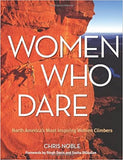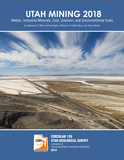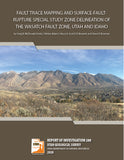Fault Trace Mapping and Surface-Fault-Rupture Special Study Zone Delineation of the Wasatch Fault Zone, Utah and Idaho (RI-280)
By: Greg N. McDonald, Emily J. Kleber, Adam I. Hiscock, Scott E.K. Bennett, and Steve D. Bowman
The Wasatch fault zone (WFZ) extends 220 miles from southeastern Idaho to central Utah. The WFZ central five segments coincide with the densely populated and continually developing Wasatch Front urban corridor, where most of Utah’s population and economy are located. Because communities on or adjacent to the WFZ are at risk of earthquake damage including surface rupture and ground shaking, knowing fault-trace locations and physical parameters are crucial in risk reduction. During 2016–2018, the Utah Geological Survey and collaborators performed updated fault mapping of thirty-nine 7.5' quadrangles along the WFZ and the WVFZ using recently-acquired lidar data. Previous geologic mapping, paleoseismic investigations, historical aerial photography, and field investigations were also used to identify and map surface fault traces and infer fault locations. Special study zones were delineated around fault traces to be used in conjunction with other geologic-hazard maps. Defining these special study-zones encourages the creation and implementation of municipal and county geologic-hazard ordinances dealing with hazardous faults. We identified potential paleoseismic sites where additional data would be critical to understanding the behavior of the WFZ and the WVFZ in Utah and Idaho. The fault geometries, attributes, and special study zones were published in the Utah Quaternary Fault and Fold Database in spring 2020. This Report of Investigation (RI-280) makes reference to the Utah Geologic Hazards Portal as the repository of the fault mapping discussed herein. However, at the time of publication of RI-280, the Utah Geologic Hazards Portal was nearing completion but not yet publicly available. Due to the March 18, 2020, magnitude 5.7 Magna earthquake, and the increased interest in the Wasatch fault zone, the Utah Geological Survey expedited publication of RI-280 and released the associated fault mapping in the Utah Quaternary Fault and Fold Database until public launch of the Utah Geologic Hazards Portal, that is where the mapping can be found. This work is critical to raise awareness of earthquake hazard in undeveloped areas of Utah experiencing rapid development and population growth.
Other Information:
Published: 2020
Pages: 23
Location: Utah
Media Type: Paper Publication









